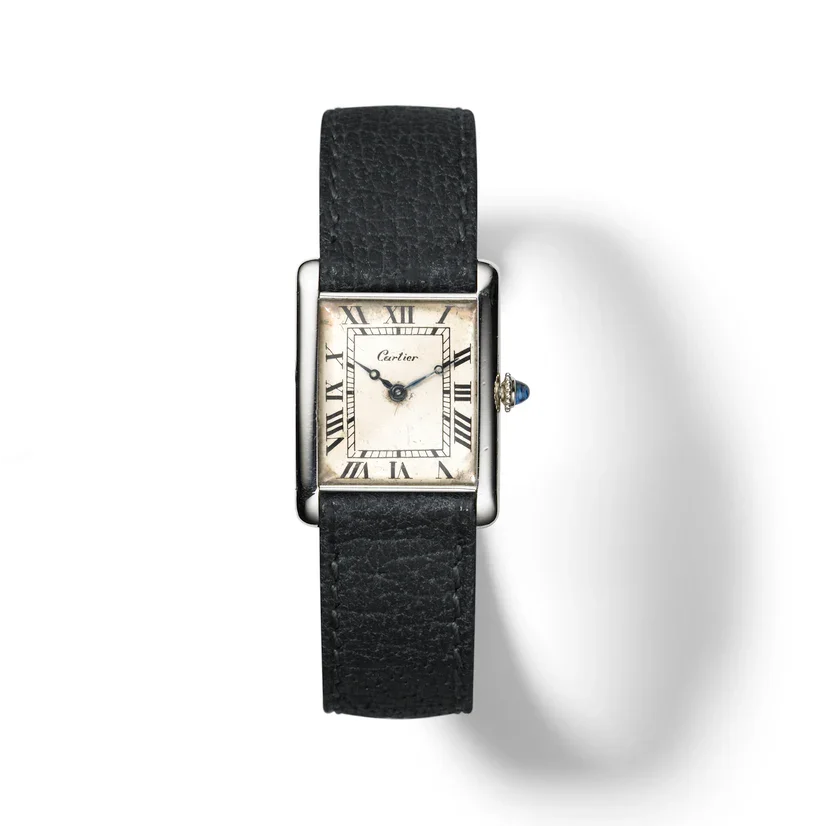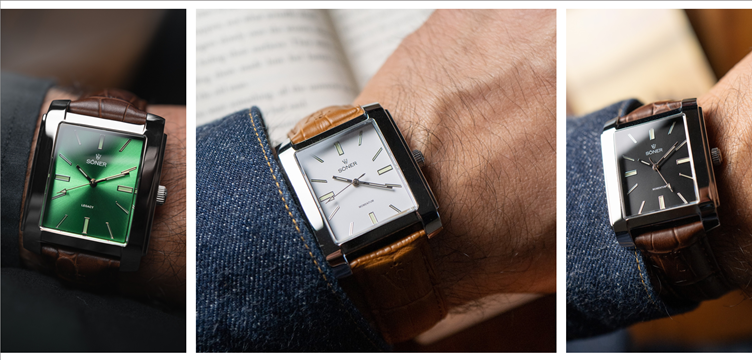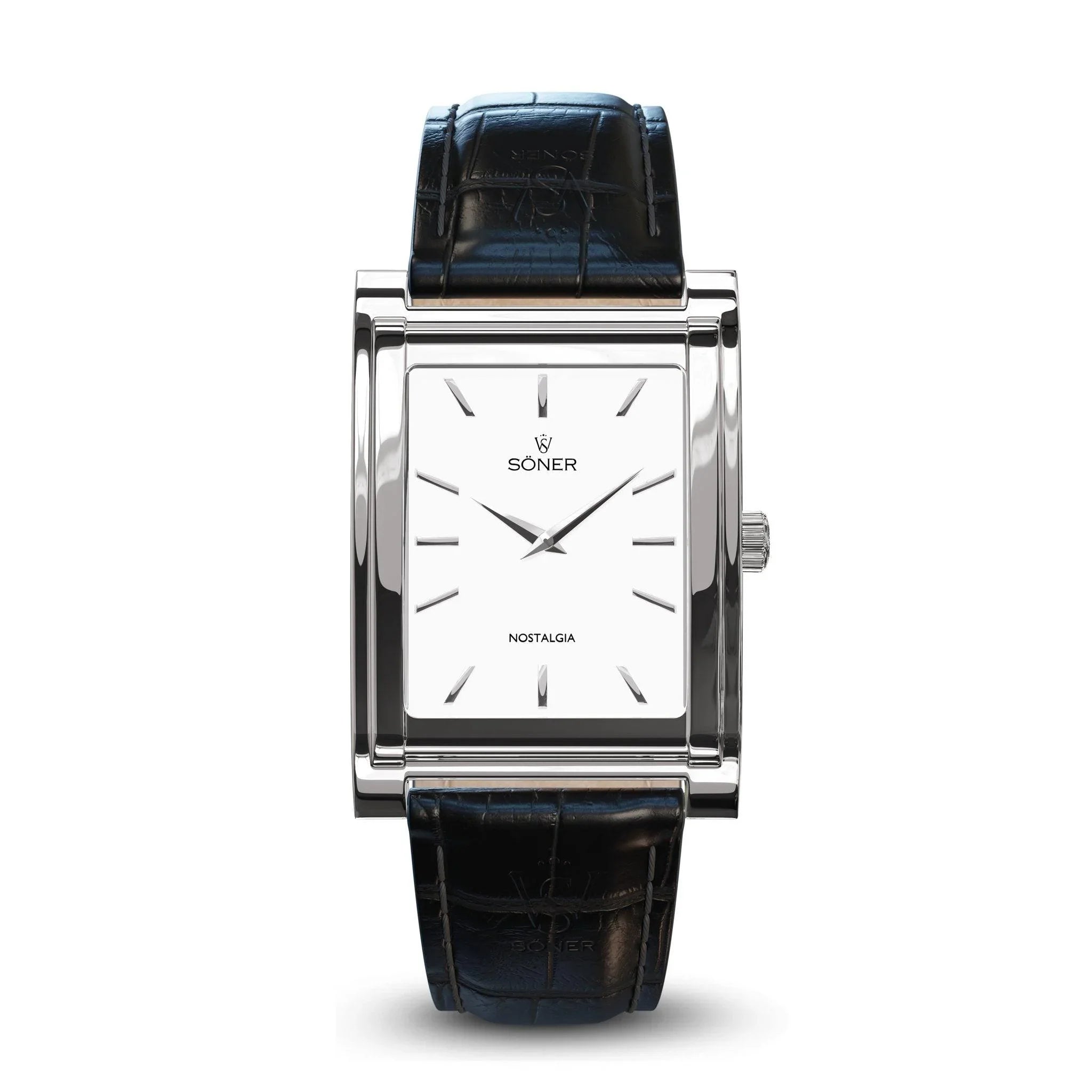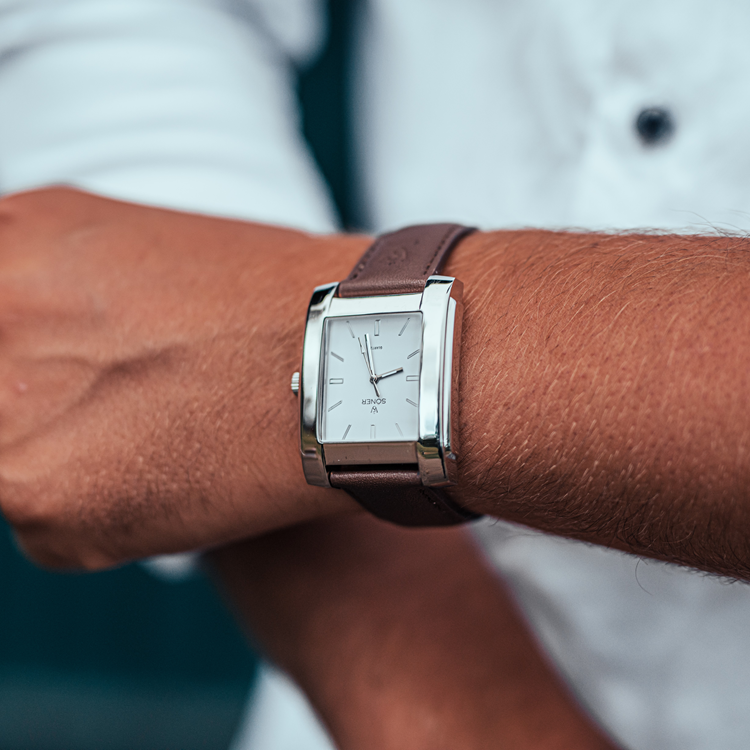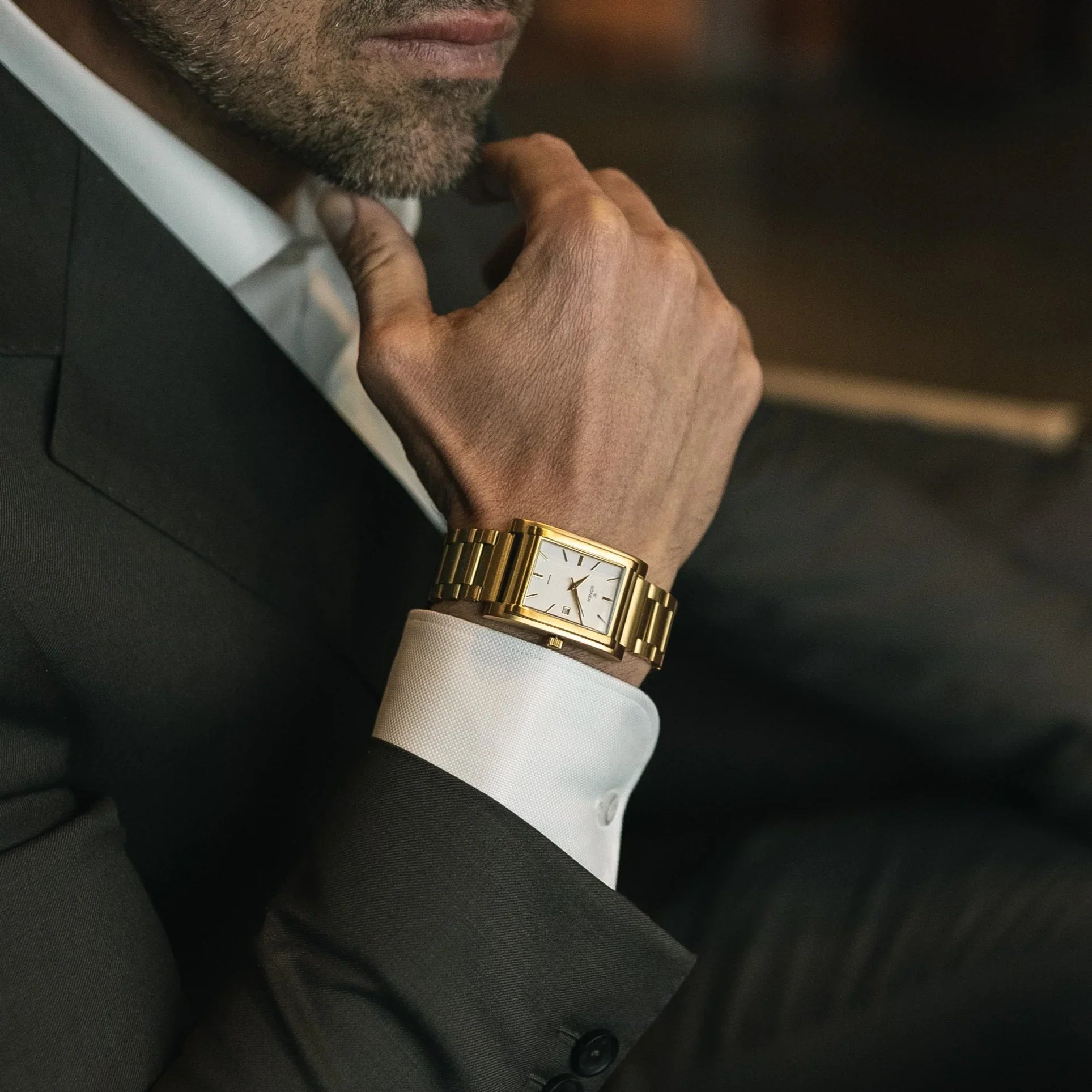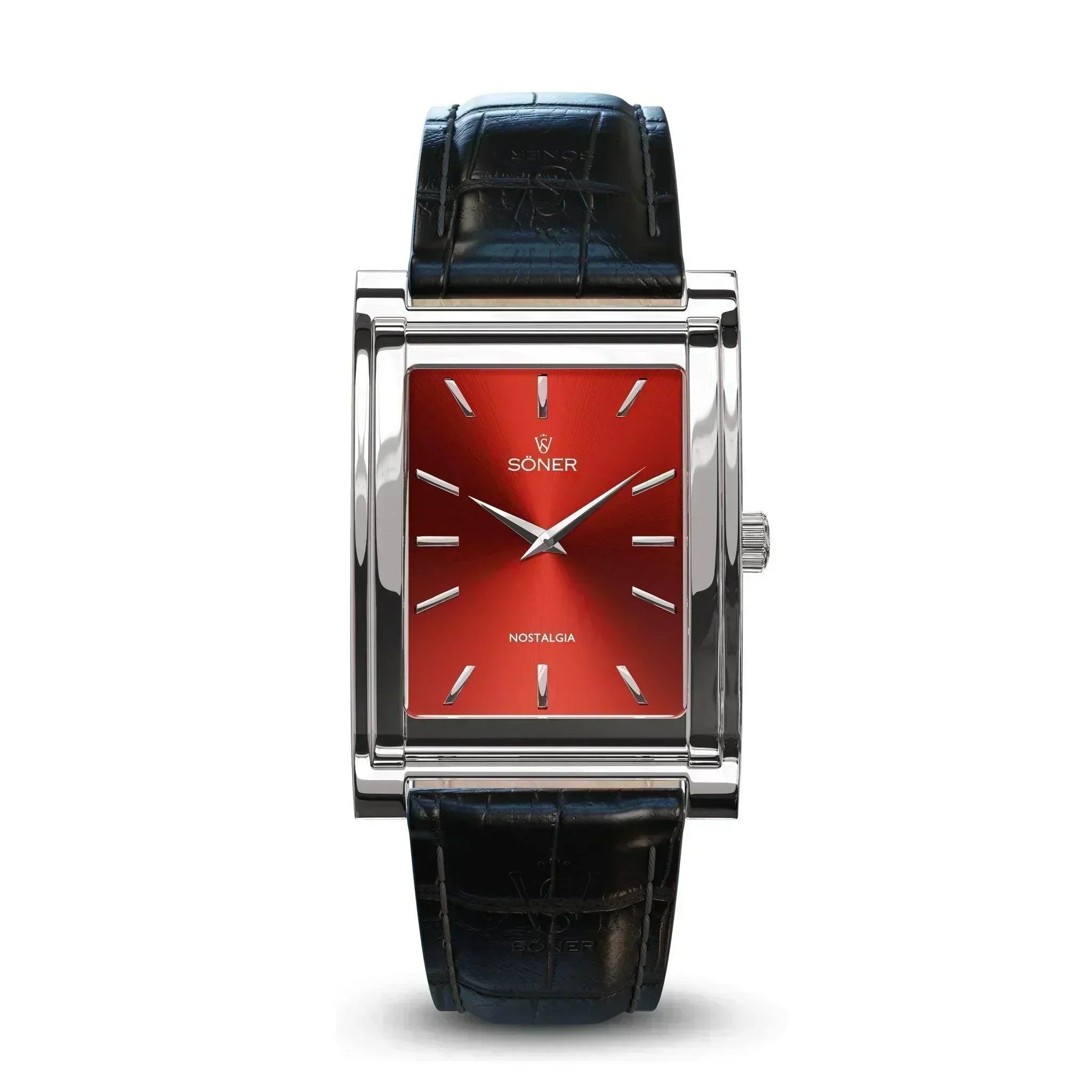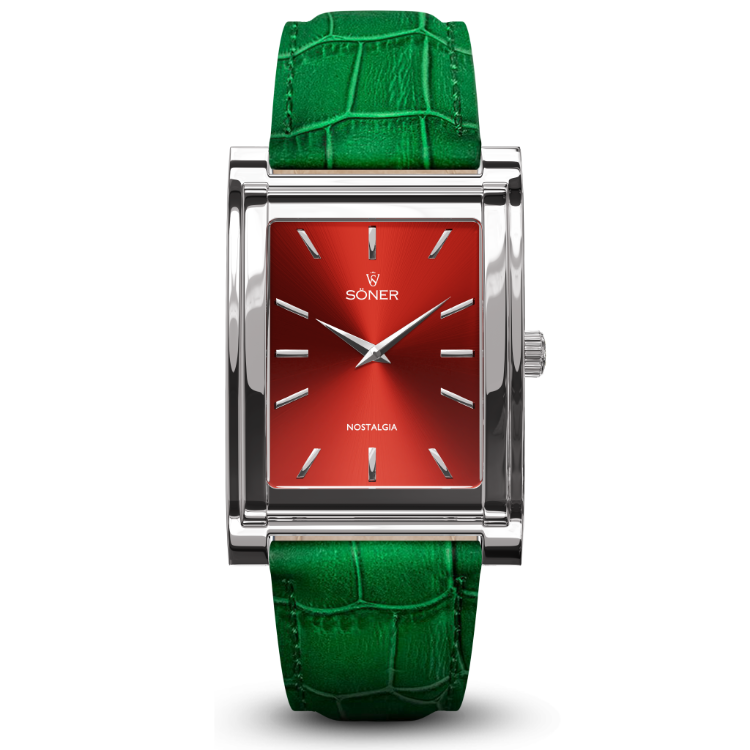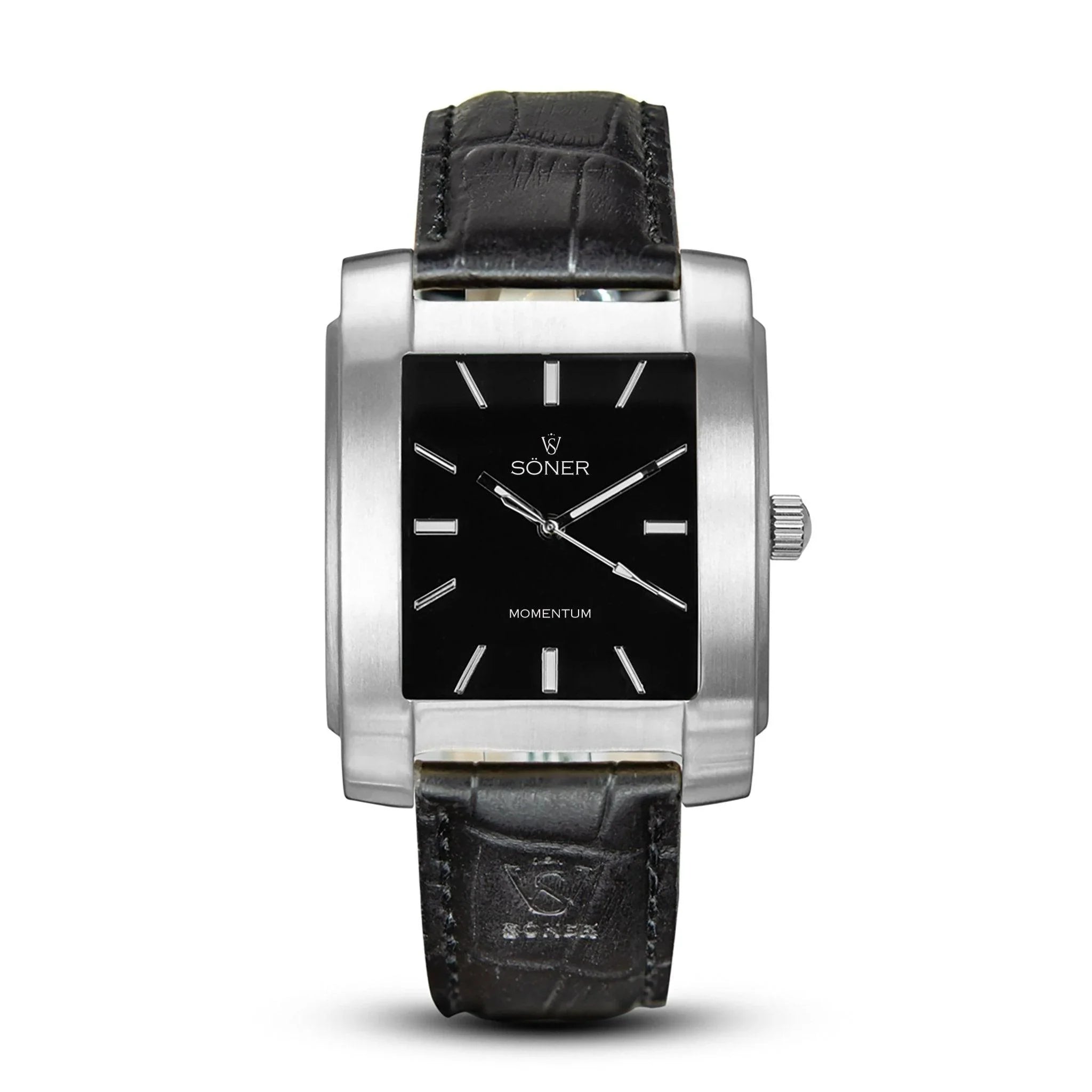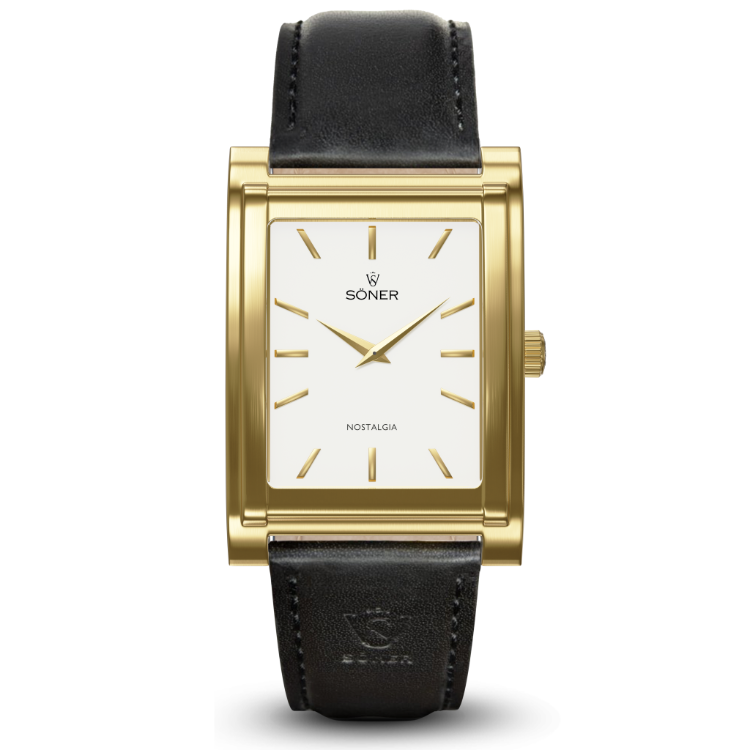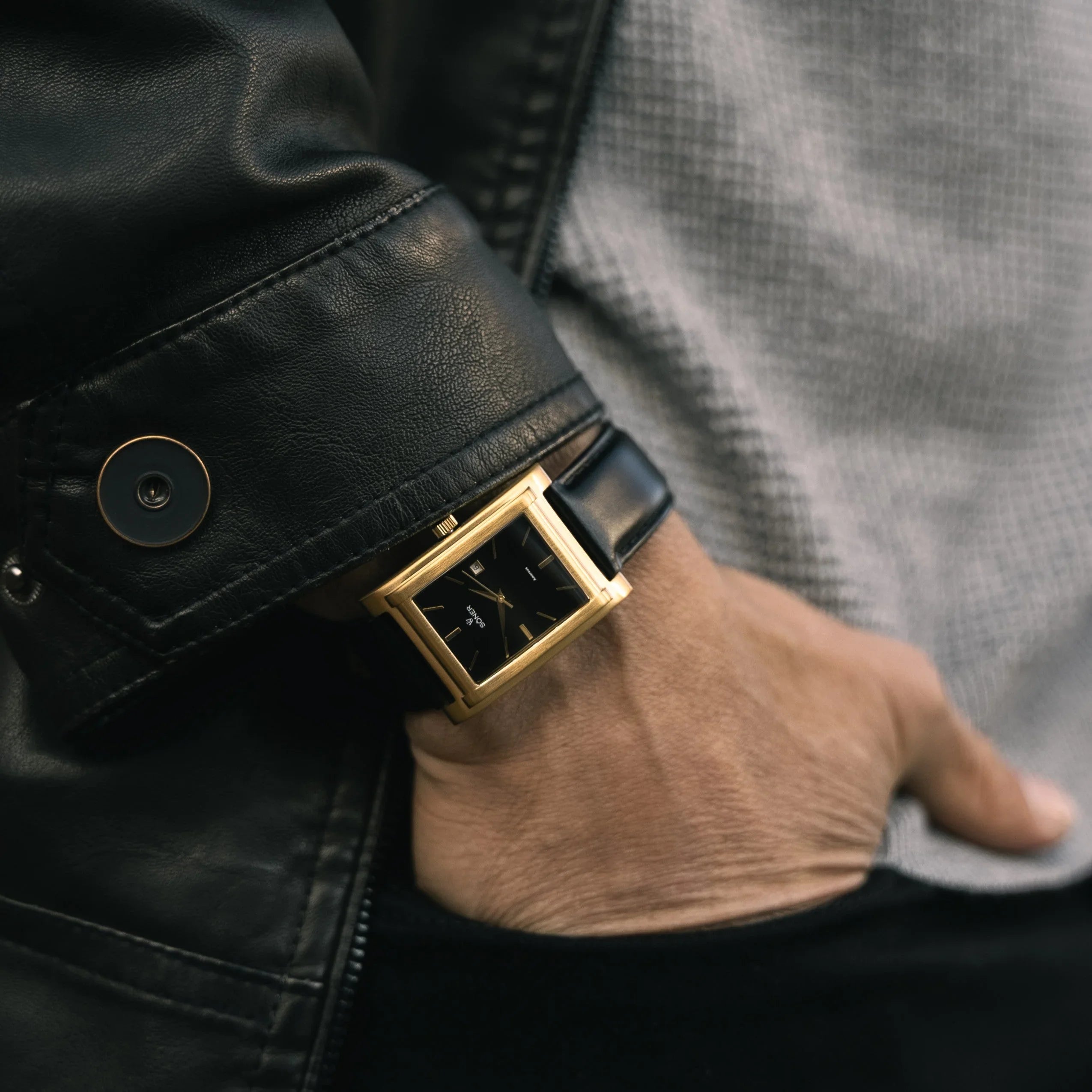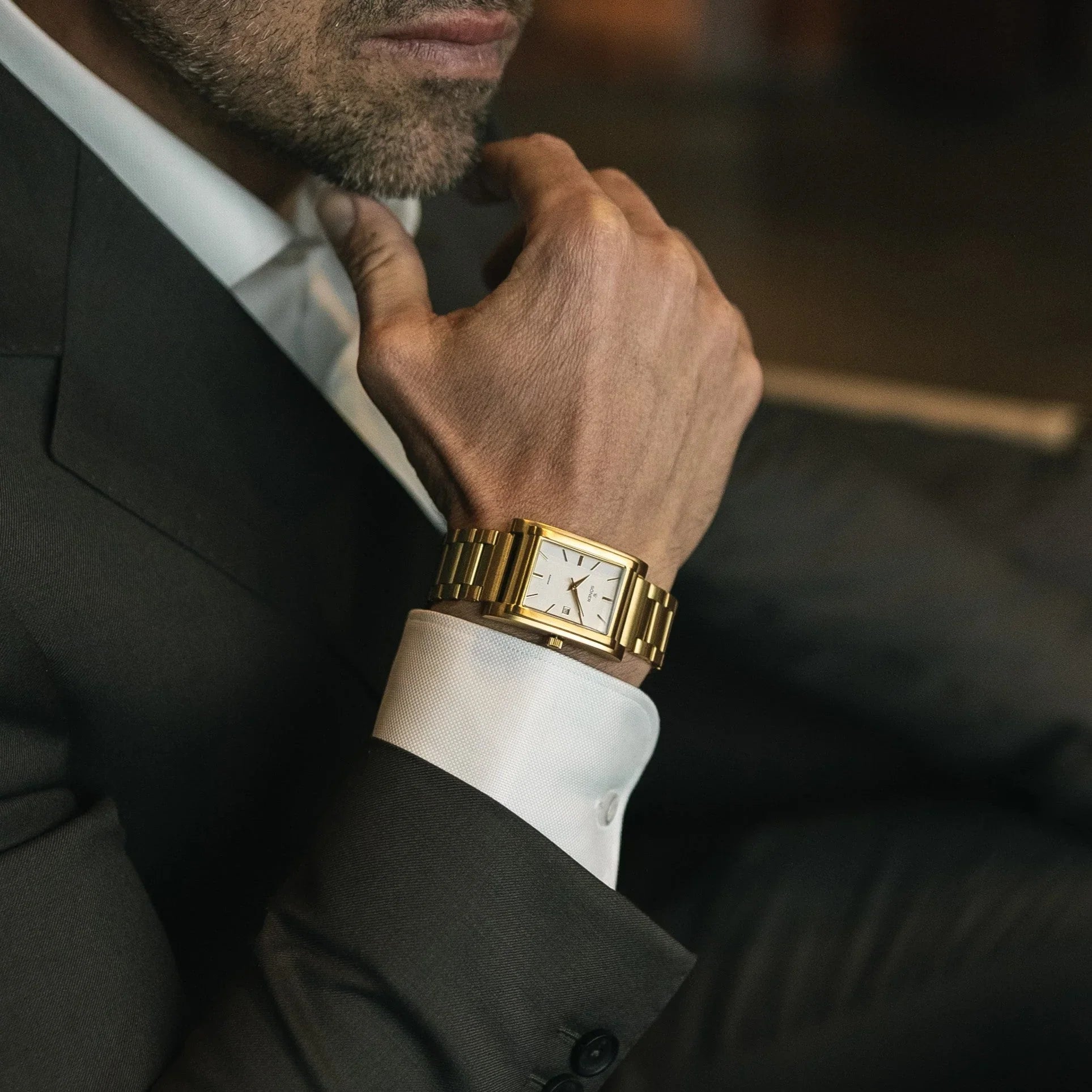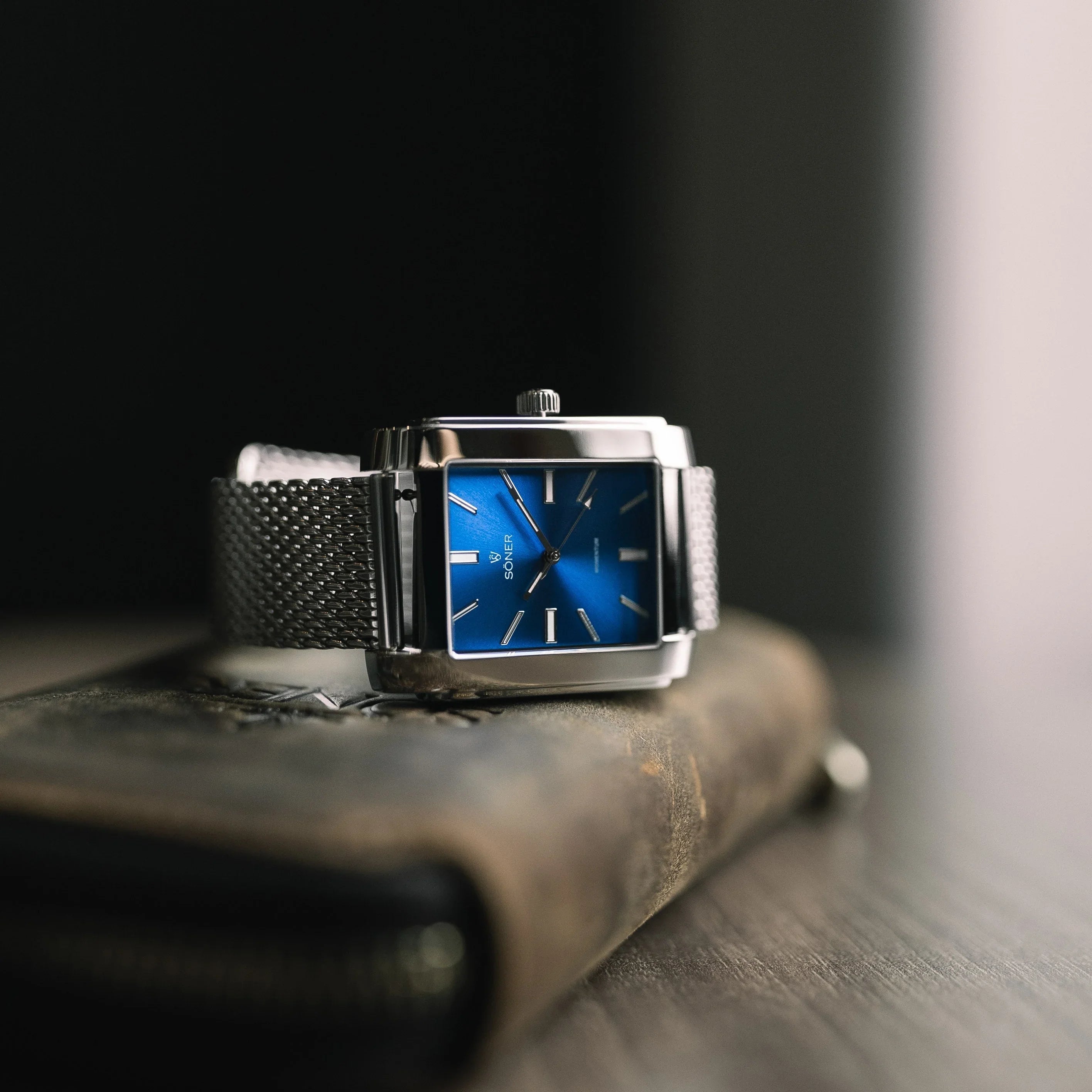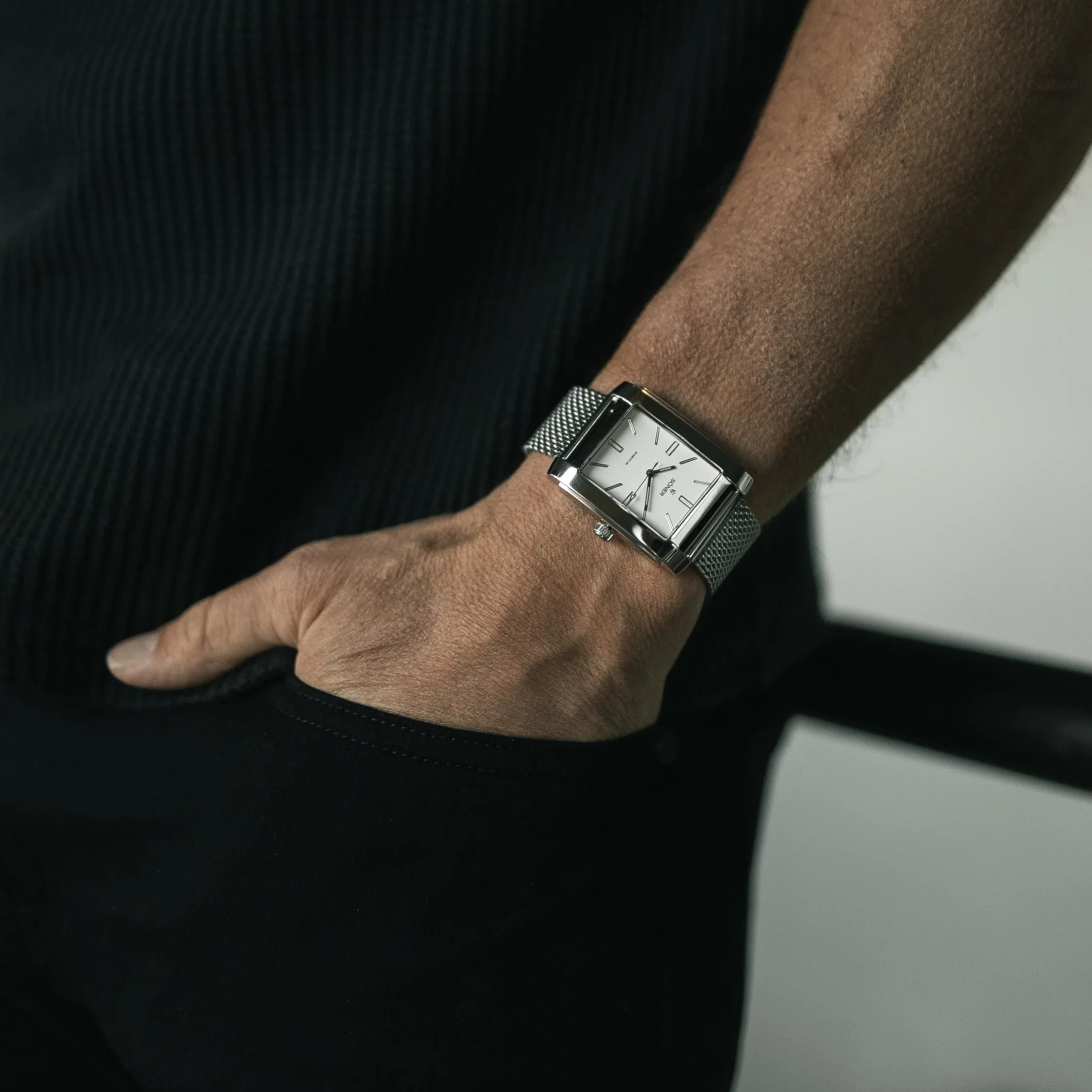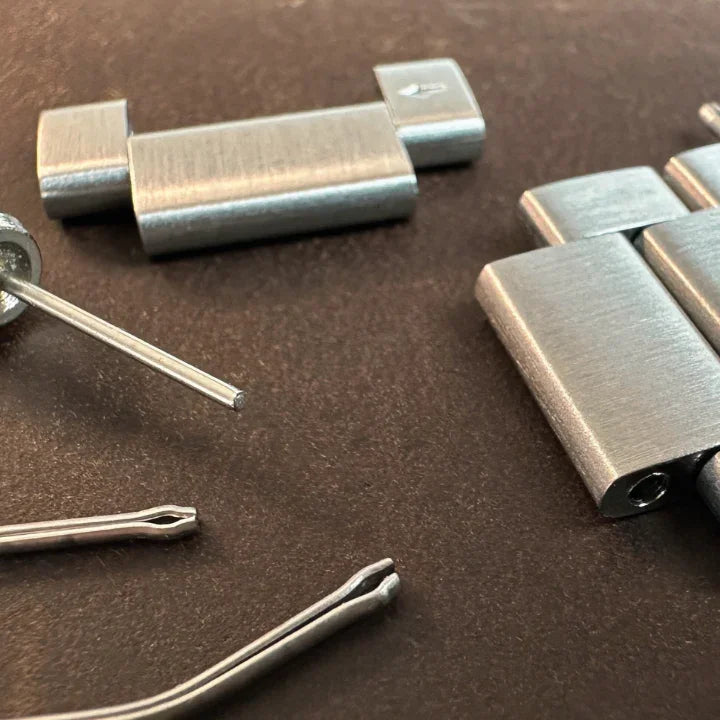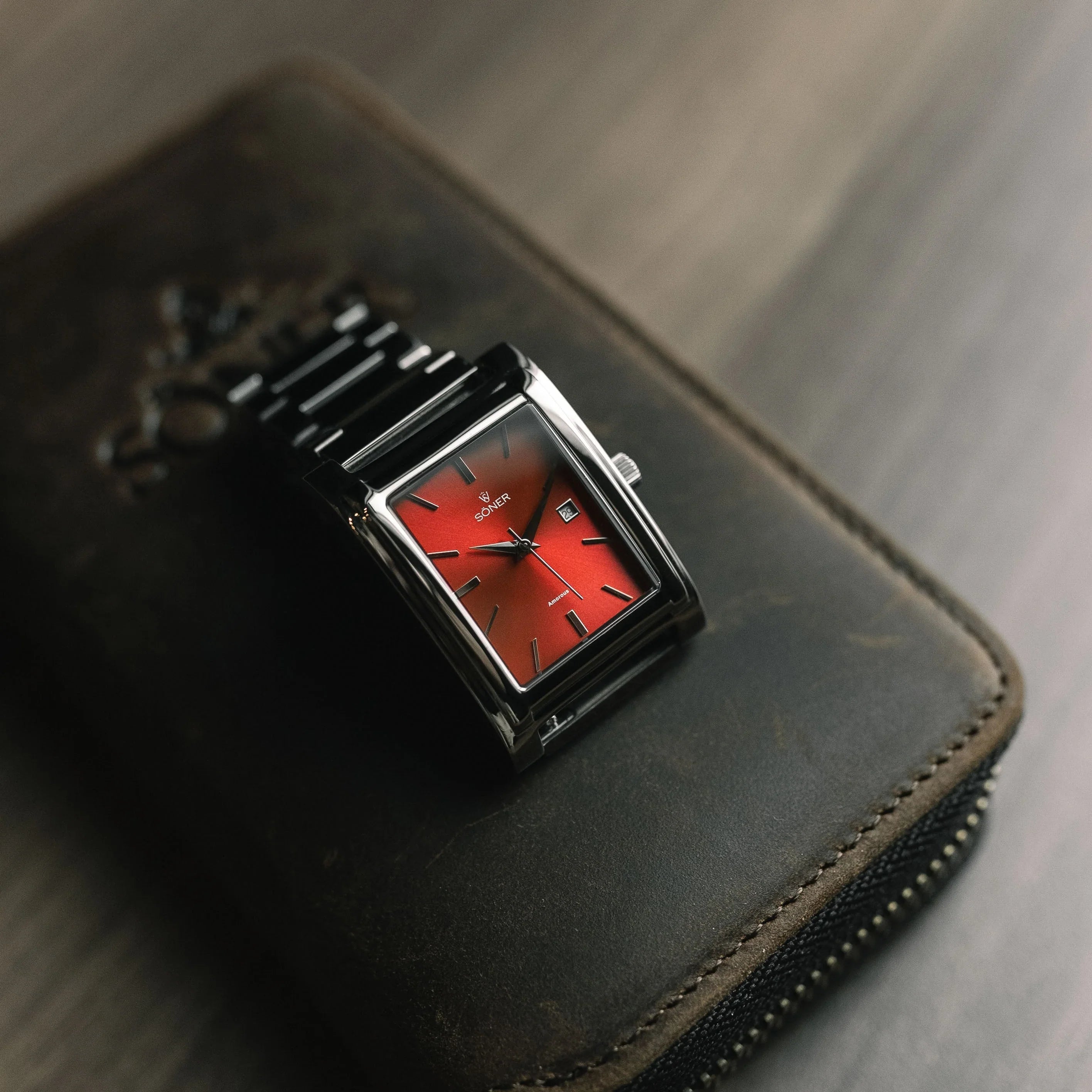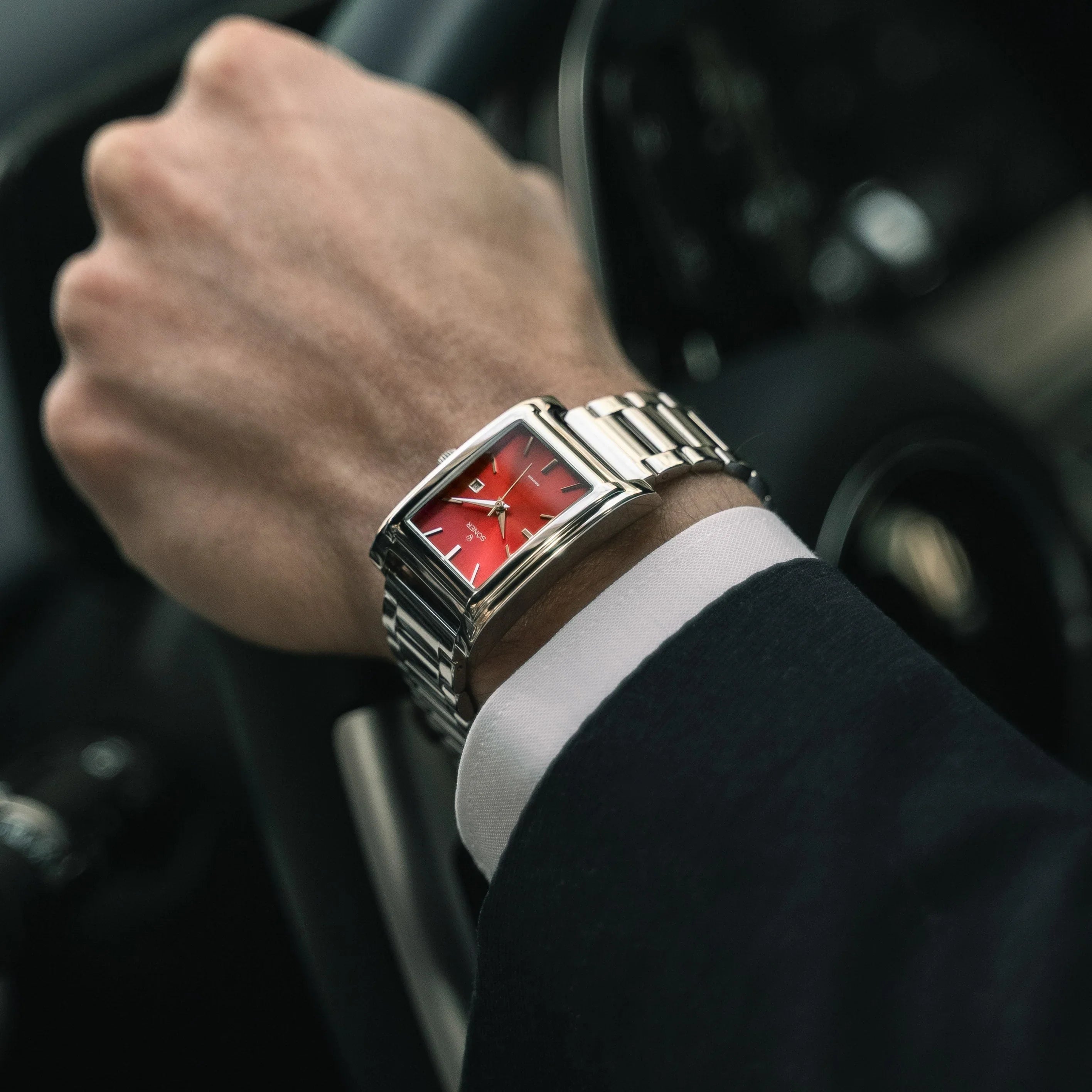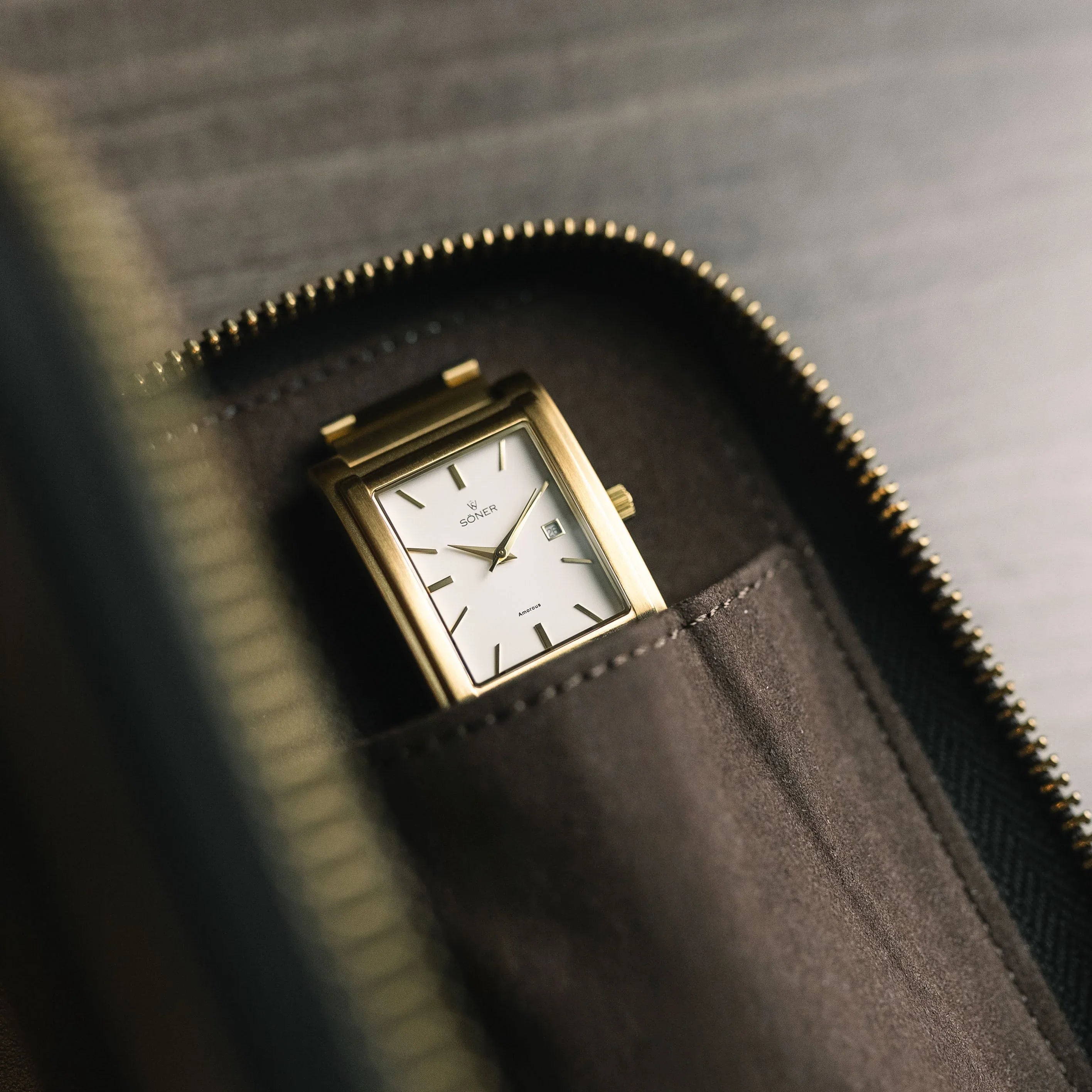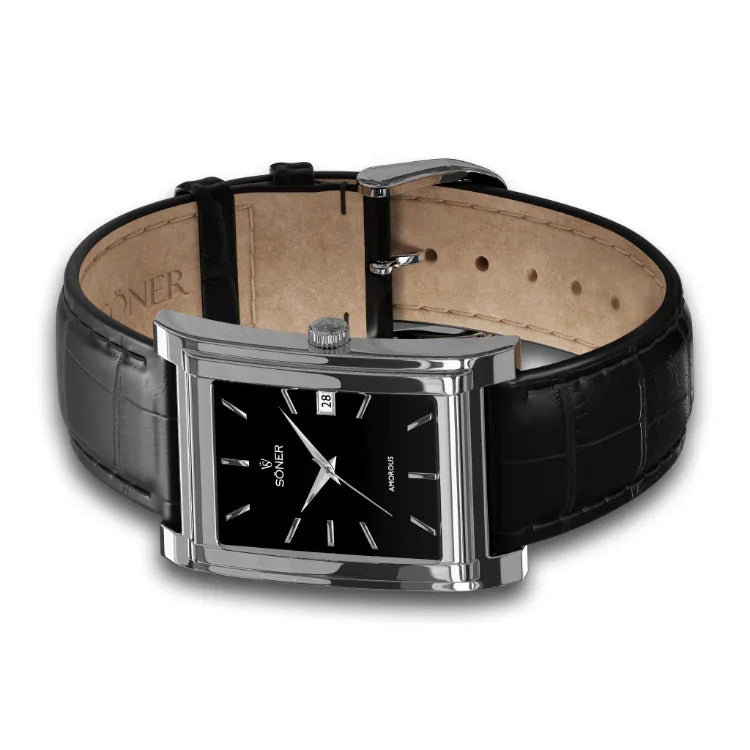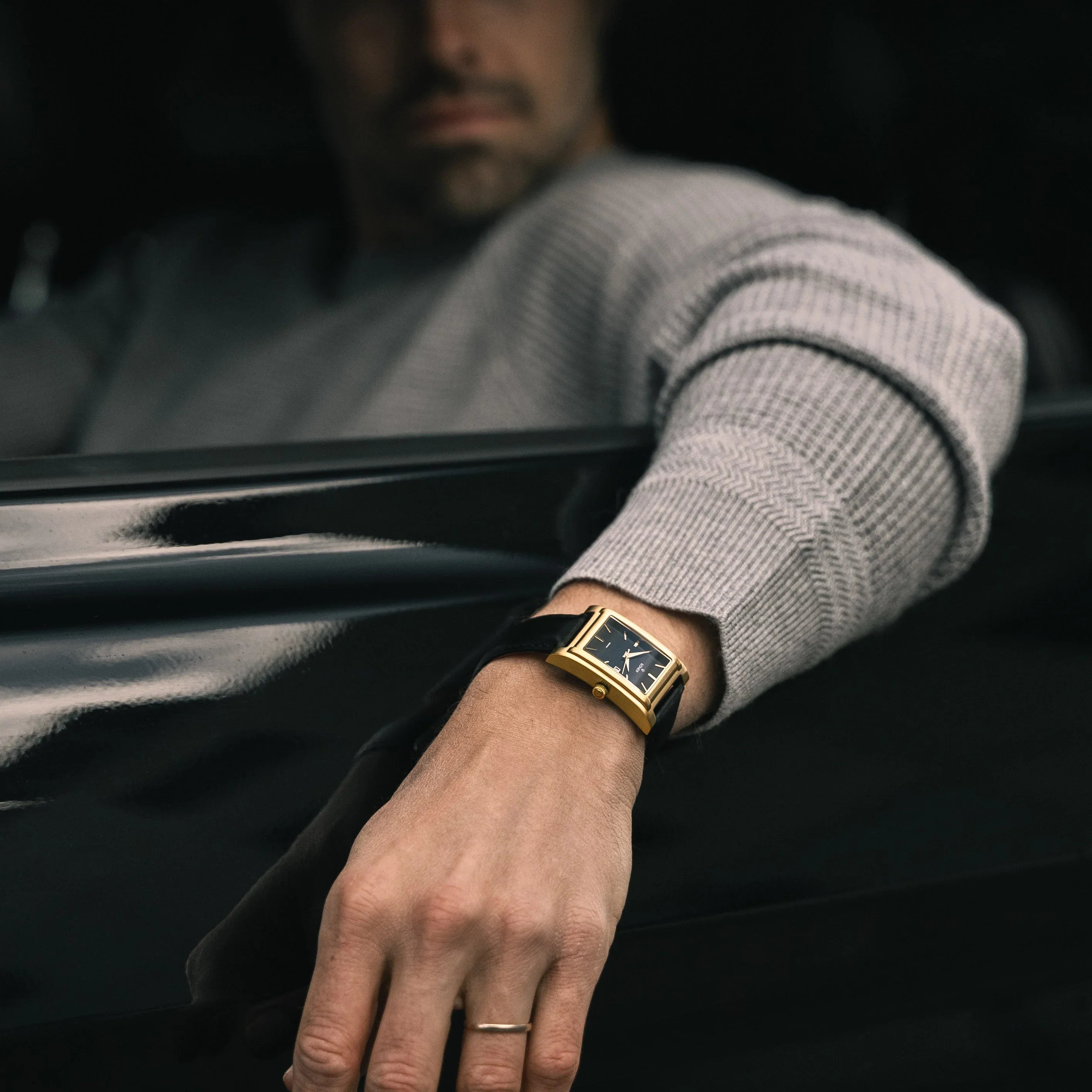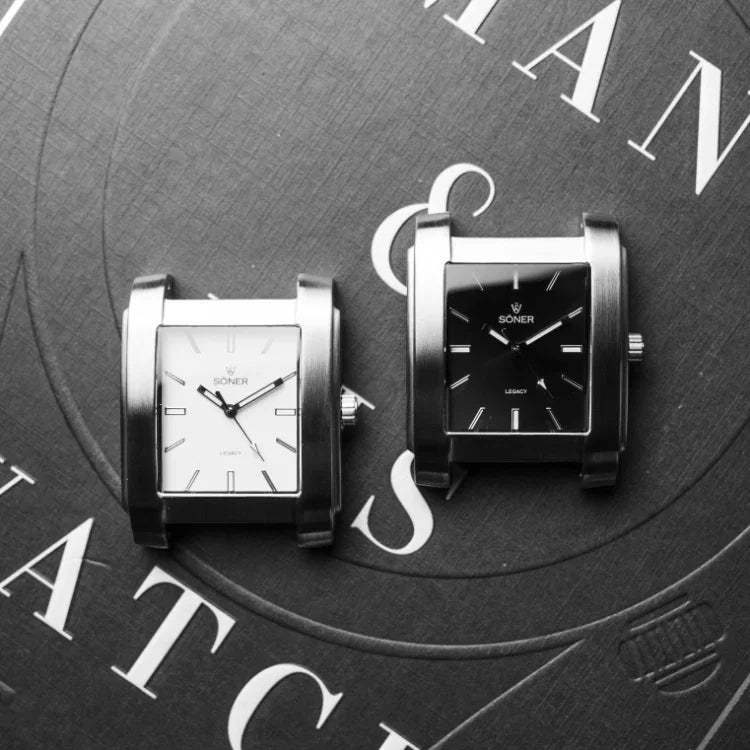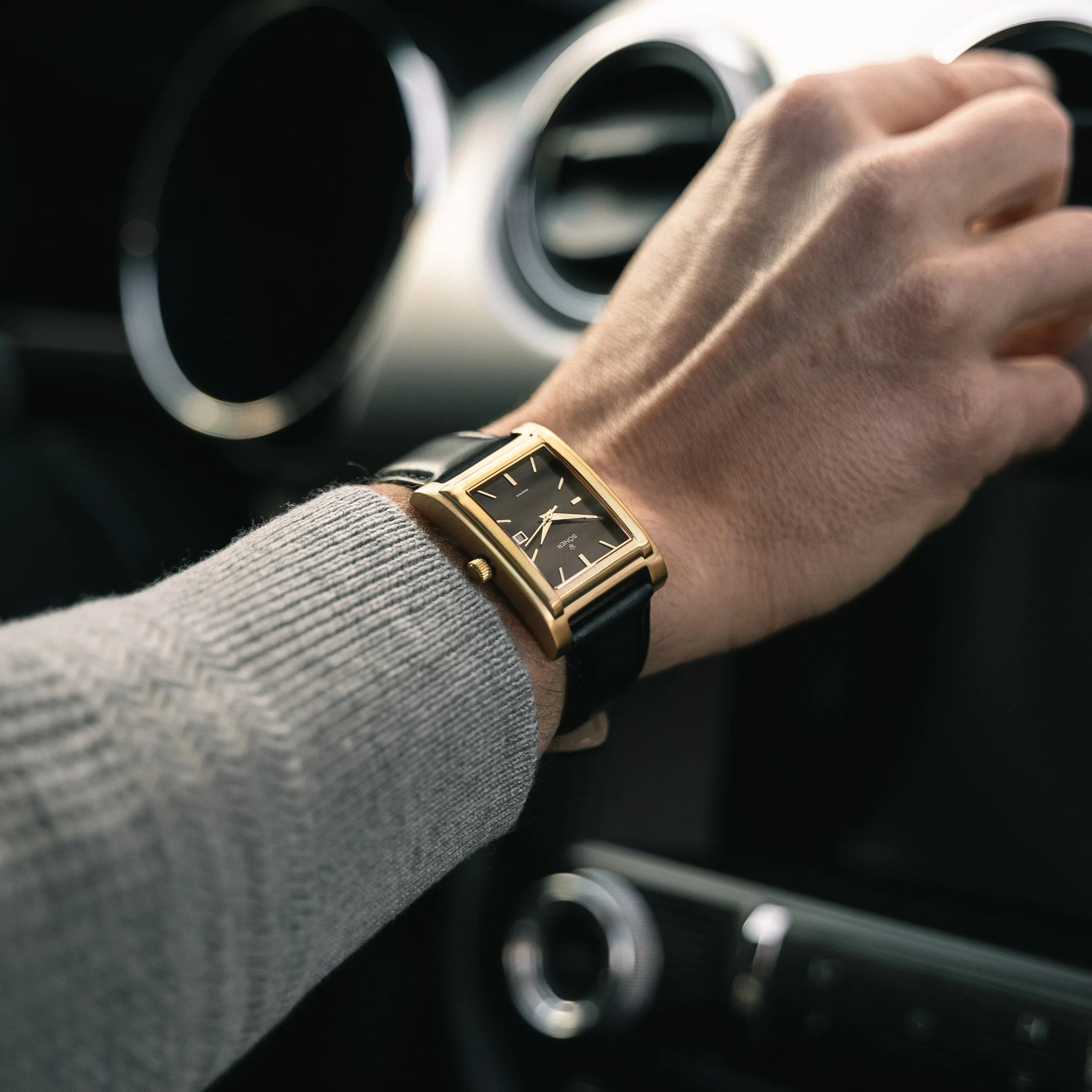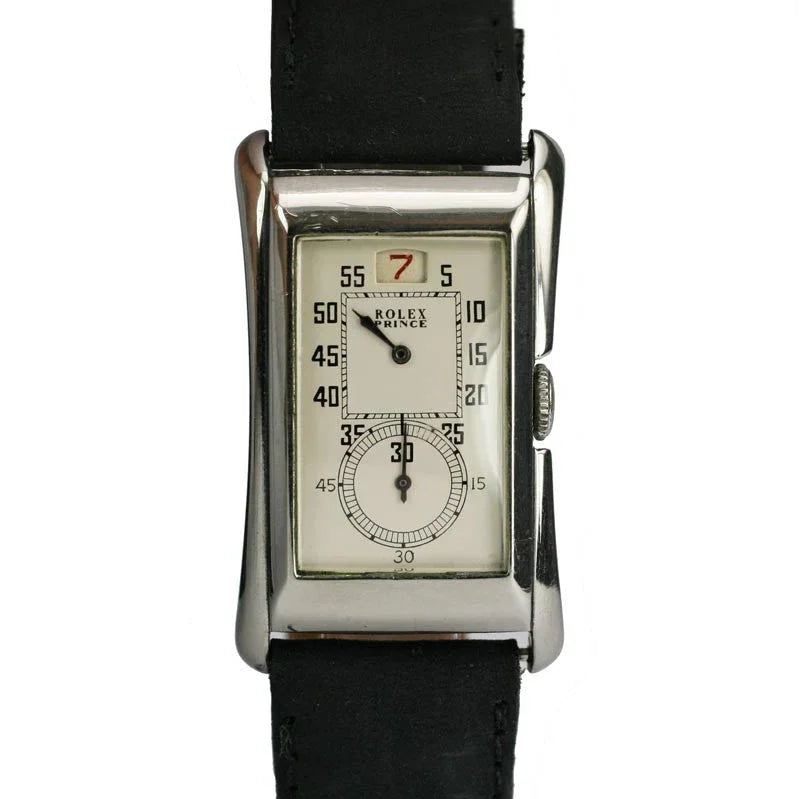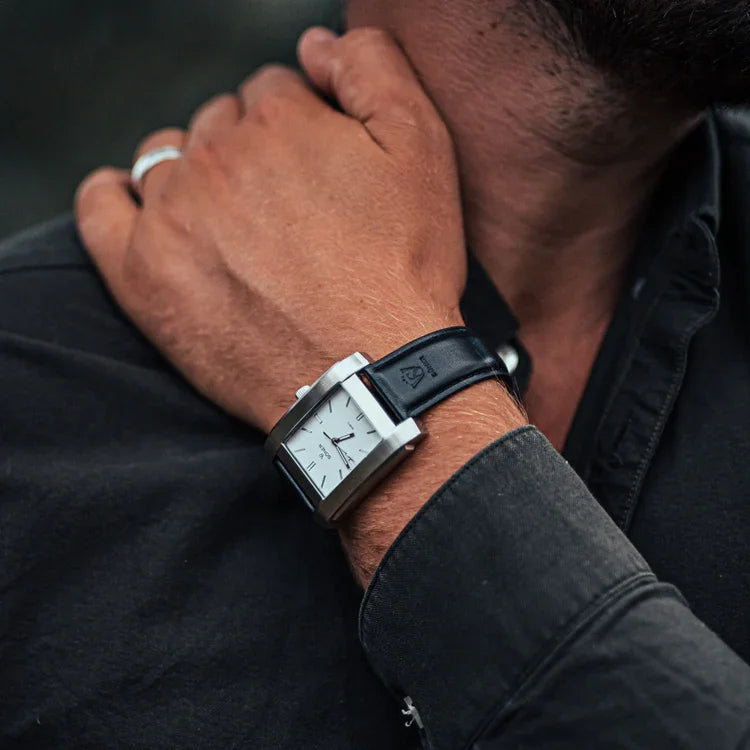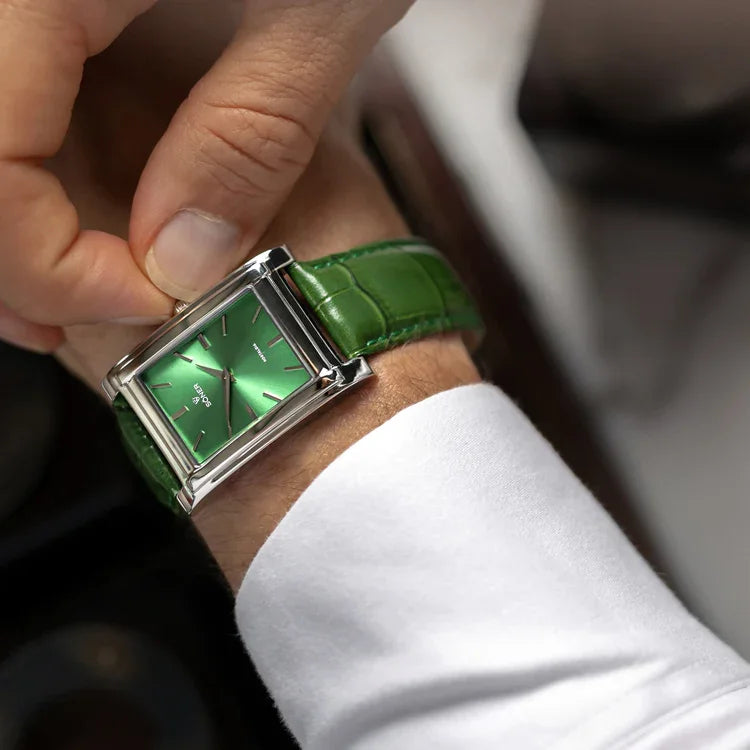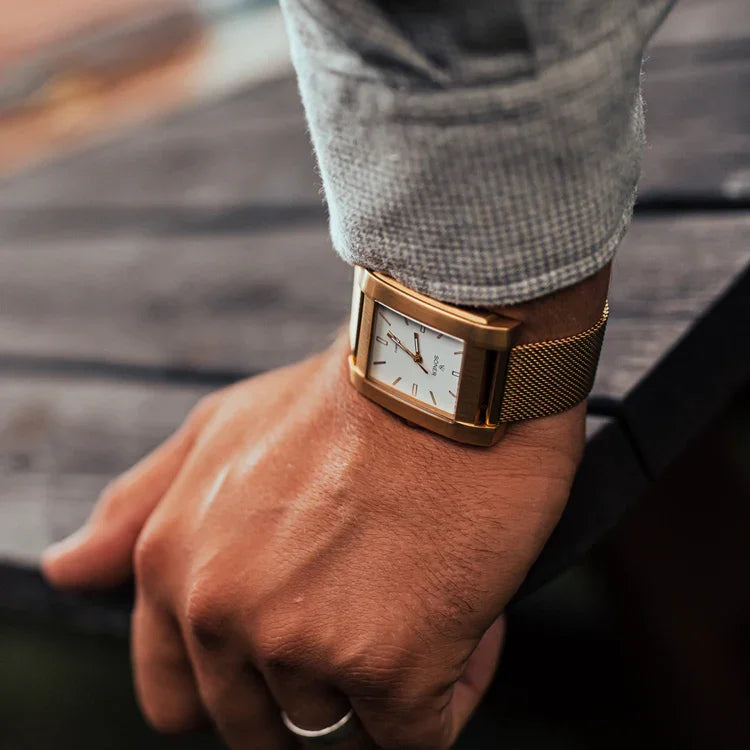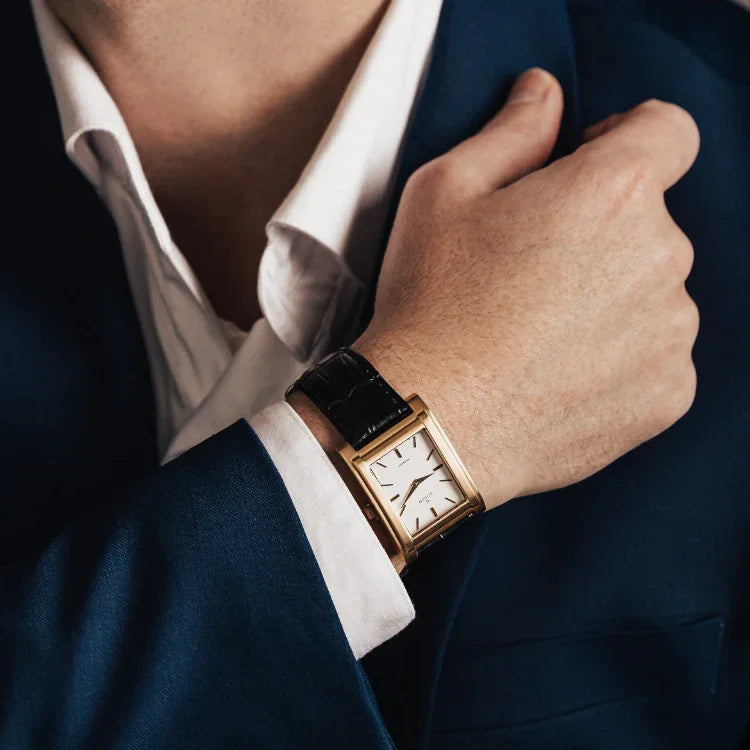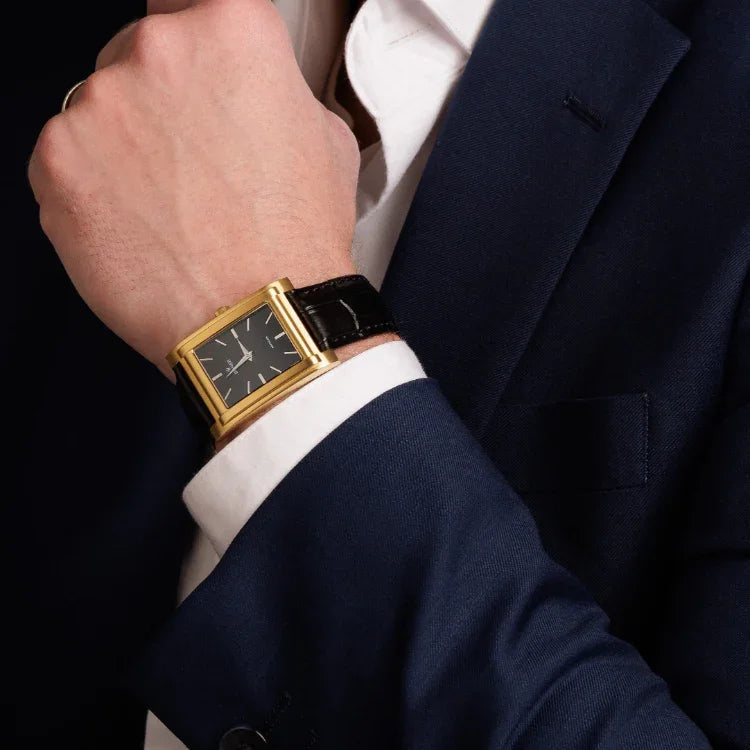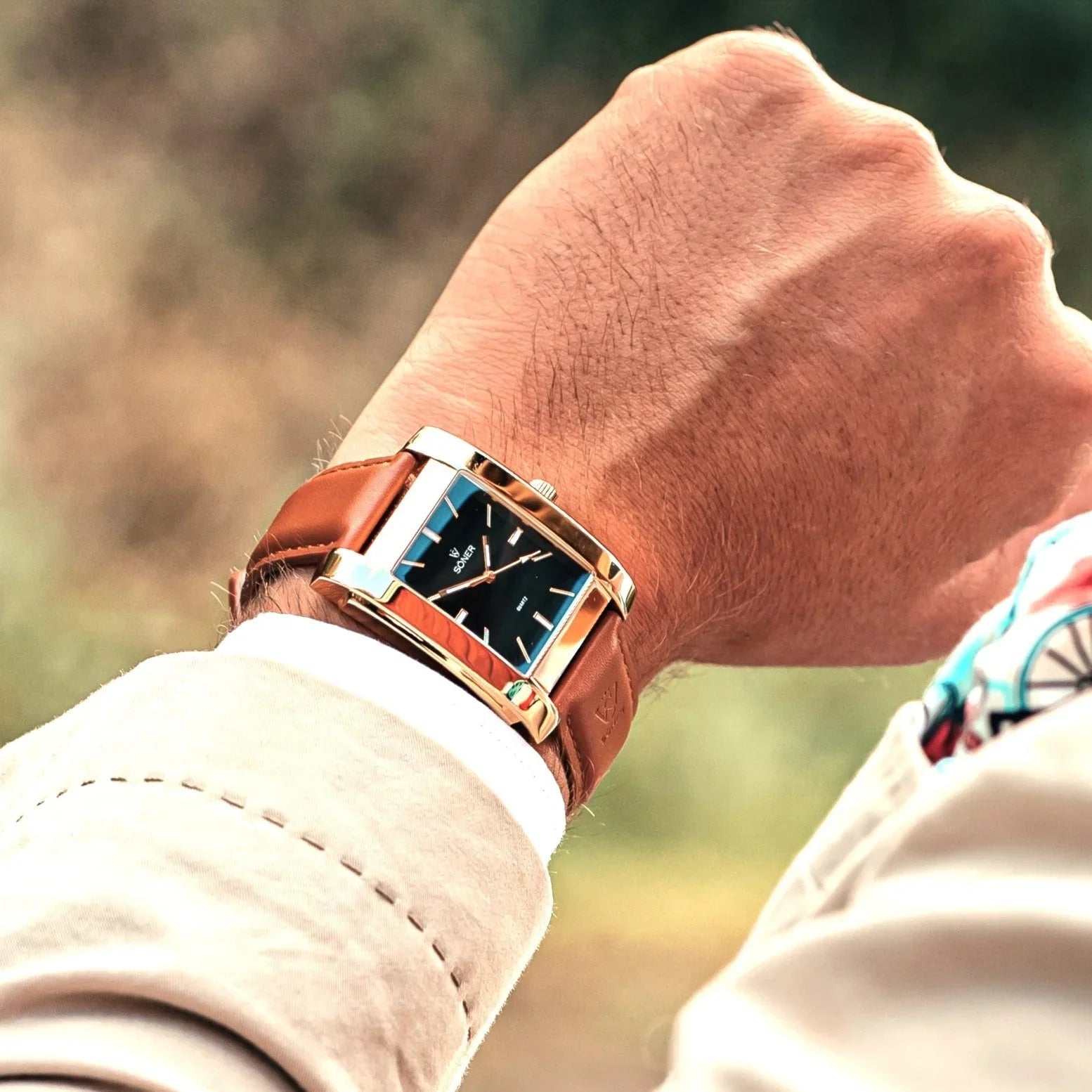Table of Contents
Pioneers in Rectangular Watchmaking

Sketch of the Santos de Cartier from the year 1911, © Cartier SA
Historically, clocks and pocket watches have predominantly featured round cases, largely due to the inherent circular nature of their internal mechanisms—comprising interlocking gears and springs. This design facilitated the rotation of hands on a circular dial, ensuring optimal legibility when indexes were arranged in a radial pattern. Additionally, the round case proved practical for crafting water-resistant timepieces, as it allowed for secure screwing of the case, thereby enhancing durability and protection against environmental elements.
Rectangular watches reached the height of their popularity during the early to mid-20th century. This era, often referred to as the golden age of watchmaking, witnessed a proliferation of innovative designs and styles, including the iconic rectangular timepieces.
Throughout the 1920s and 1930s, rectangular watches continued to gain popularity, particularly among the fashion-forward elite. Brands like Jaeger-LeCoultre, Cartier, Vacheron Constantin, Rolex, Omega, and Patek Philippe all embraced this geometric trend, producing exquisite timepieces that combined artistry with technical innovation. These watches adorned the wrists of style icons and trendsetters, cementing their status as coveted accessories.
However, as tastes evolved and watchmaking technology advanced, the popularity of rectangular watches waned in favor of more traditional round designs. For decades, round watches dominated the market, relegating rectangular timepieces to niche status.
Fast forward to the 21st century—there has been a resurgence of interest in rectangular watches. As consumers seek unique and distinctive timepieces that stand out from the crowd, rectangular designs are once again gaining traction. Watchmakers are embracing the geometric trend, reintroducing classic models, and unveiling new interpretations of the rectangular watch. A century later, the pendulum has swung back rectangular watches are making a comeback. Today, these iconic timepieces continue to attract collectors and enthusiasts with their timeless appeal and enduring style, showing that great design never goes out of style.
Cartier
At the start of the 20th century, Cartier emerged as a leader in luxury watchmaking, redefining elegance with its iconic designs and impeccable craftsmanship. While the Cartier Santos is recognized as the first rectangular watch, there's an even more iconic Cartier model that has given its name to a whole category of watches: the Tank watch.
Cartier – The Tank
When discussing rectangular watches, one cannot overlook the iconic Cartier Tank timepiece. Revered for its timeless elegance and distinctive rectangular shape, the Cartier Tank has impacted the world of horology. In fact, the term tank has become synonymous with this particular shape of watch in the watchmaking community.
The Cartier Tank was first introduced in 1917, drawing inspiration from the Renault FT-17 tanks used during World War I. Its unique design features a rectangular case with clean lines and a minimalistic aesthetic, reflecting the Art Deco movement of the early 20th century. The watch was revolutionary for its time, defying the traditional round shape that had dominated the watch industry. The Cartier Tank quickly became a symbol of sophistication and elegance, favored by celebrities, royalty, and tastemakers alike.
Vintage Cartier Tank, © Cartier SA
Over the years, the Cartier Tank has become an enduring symbol of sophistication and refinement. Its sleek silhouette and understated elegance have made it a favorite among discerning individuals, from royalty and celebrities to tastemakers and trendsetters. The Tank has transcended generations and continues to be a coveted accessory for those who appreciate timeless design and impeccable craftsmanship.
In addition to its aesthetic appeal, the Cartier Tank is also celebrated for its historical significance. It has graced the wrists of many notable figures throughout history, including world leaders, artists, and cultural icons. Each iteration of the Tank tells a story of innovation and creativity, showcasing Cartier's dedication to pushing the boundaries of watchmaking.
Jaeger-LeCoultre:
As a pioneer of Swiss watchmaking, Jaeger-LeCoultre has earned a reputation for precision engineering, technical innovation, and unparalleled craftsmanship. With a legacy spanning nearly two centuries, Jaeger-LeCoultre has consistently introduced groundbreaking complications and iconic designs.
With over 1242 movements and 400 registered patents, it's no surprise that Jaeger-LeCoultre commands the highest regard among collectors. With 187 years of expertise behind each timepiece, owning a Jaeger-LeCoultre watch is an investment in craftsmanship and legacy.
From the iconic Reverso to the bold designs of its Master Control collection, Jaeger-LeCoultre has redefined the rectangular watch, expertly blending form and function. With its innovative spirit and strong commitment to excellence, Jaeger-LeCoultre continues to influence the future of watchmaking, inspiring enthusiasts and collectors across generations.
Jaeger-LeCoultre's – The Duoplan
Introduced in 1925, the Duoplan stood as one of Lecoultre's pre-eminent icons during the Art Deco period. In fact, the famous Reverso conceived approximately six years later, emerged as a testament to this momentous design. Named the DuoPlan, it paid homage to the structure of its movement. During this era, the trend favored exceedingly small wristwatches. However, such extreme miniaturization often compromises reliability.
The Duoplan ingeniously addressed this challenge by adopting a dual-level movement, thereby harmonizing technical excellence with elegance. This innovative approach ensured the retention of a large-size balance, facilitating more precise timekeeping.
Jaeger-LeCoultre's – The Reverso
The story behind Jaeger-LeCoultre's iconic timepiece, The Reverso is one of innovation, collaboration, and a quest for practical elegance.
In the 1930s, there was a significant shift in men's wristwatches, with functional elegance becoming a key focus. This change was driven by the growing popularity of sportswear, highlighted by influential figures like the Prince of Wales and tennis player René Lacoste. Their preference for practical outfits, including knickerbockers and half-sleeve shirts, revolutionized ideas of style and comfort, paving the way for new trends in wristwear.
The advent of sportswear, particularly the tennis or polo shirt played a pivotal role in reshaping attitudes toward appropriate attire, akin to the impact wielded by the wristwatch. However, despite its growing popularity, the wristwatch faced a challenge in attaining the purposeful practicality synonymous with the polo shirt, as highlighted by businessman César de Trey during a business trip to India in 1930.
Eager to meet the demands posed by British colonial army officers in India for a wristwatch robust enough to withstand the rigors of a polo match, de Trey embarked on a quest for innovation. He enlisted the expertise of micromechanics masters Jacques-David LeCoultre and Edmond Jaeger, renowned for their proficiency in miniaturization demonstrated through the Duoplan watch in 1925.
The challenge was met with the help of French designer René-Alfred Chauvot, who crafted a flawless rectangular case. This design was patented under application No. 712868 at the French Ministry of Trade and Industry on March 4, 1931. The case featured a unique mechanism that allowed it to slide and flip over completely. Decorated with Art Deco elements like baton-shaped hands, dart-type indexes, Arabic numerals, and a swiveling case adorned with three decorative gadroons at the top and bottom, the Reverso watch quickly won over enthusiasts with its innovative design.
Jaeger-Lecoultre Reverso, © Matthew Bain
The Reverso's design was not driven by a desire for novelty but by functionality, making it a quintessential Art Deco product. Its value lies in the ingenuity and intricacy of its engineering rather than the costliness of materials or lavish embellishments. Thus, the Reverso emerged as a triumph of innovation and a timeless icon of functional elegance in the world of horology.
The success of the Reverso wasn't just about its striking look; its practicality played a big part too. The watch's design focused on mechanical ingenuity over mere decoration. The Reverso stood out for its complex engineering and innovative construction, establishing it as a quintessential Art Deco masterpiece.
Since its launch, the Reverso has stood the test of time and fashion, securing its status as a timeless icon in watchmaking. Its lasting legacy highlights Jaeger-LeCoultre's dedication to excellence and innovation and it continues to inspire watch enthusiasts and collectors around the globe.
Patek Philippe
Patek Philippe is a leading force in watchmaking, known for its steadfast commitment to excellence and innovation. With a history that stretches over 180 years, Patek Philippe has had a significant impact on the development of watchmaking, defining the standards of craftsmanship in the industry. At the core of Patek Philippe's impact is its relentless pursuit of perfection. Every detail, from intricate movements to the exquisite finishing of each component, showcases the brand's dedication to precision and quality.
Patek Philippe also made a significant mark on the art of watch design. Balancing tradition with innovation, the brand has introduced iconic timepieces that have pushed the boundaries of watch aesthetics. Models like the elegantly timeless Calatrava and the technologically advanced Grandmaster Chime are the perfect examples of how Patek Philippe watches marry form and function seamlessly.
In short, Patek Philippe's impact on watchmaking is not just about superb craftsmanship—it's about embodying a philosophy that values timeless elegance, innovation, and unwavering quality. As a pillar of horological excellence, Patek Philippe continues to influence the future of watchmaking while honoring its rich heritage.
Patek Philippe – The Eiffel Tower
The Patek Philippe Reference 2441, introduced in 1948 and often referred to as the Eiffel Tower, highlights the brand's commitment to exquisite craftsmanship. This remarkable timepiece derives its nickname from the distinctive design of its lugs, which bear a striking resemblance to the iconic lattice structure of the Eiffel Tower.
Patek Philippe Eiffel Tower, © Matthew Bain
The Reference 2441 features a rectangular case, a bold deviation from the traditional round watches of its era. This design choice underscores Patek Philippe's readiness to challenge norms and explore new shapes in watchmaking.
The elegance of the Reference 2441 is rooted not only in its distinct appearance but also in its technical excellence. Equipped with a manual-winding movement, this watch is a testament to the precision and reliability that Patek Philippe is known for. Its clean dial, with Arabic numerals, baton hour markers, and sleek hands, ensures easy readability while exuding sophistication.
As a collector’s item, the Patek Philippe Reference 2441 is highly valued by watch enthusiasts for its rarity and historical importance. Each piece narrates a story of innovation, exceptional craftsmanship, and enduring elegance, reflecting the lasting legacy of Patek Philippe in the watchmaking industry.
Patek Philippe – The Banana
The Patek Philippe Ref. 2442, affectionately known as "The Banana," is a testament to the brand's innovation and craftsmanship during the mid-20th century. Introduced in the 1940s, this unique timepiece stands out with its distinctive curved, rectangular case that resembles the shape of a banana, hence its nickname. The design is a bold departure from traditional watch shapes, reflecting Patek Philippe's willingness to push the boundaries of conventional watchmaking.
Crafted in yellow or pink gold, the Ref. 2442 features a stunning, elongated case with gracefully flared lugs that add to its elegant yet unconventional appearance. The dial, typically adorned with simple, classic markers and dauphine hands, maintains a clean and sophisticated look, ensuring that the watch remains timeless despite its unusual shape.
Patek Philippe Banana, © Matthew Bain
The Ref. 2442 is powered by a manually wound mechanical movement. Over the years, this model has become a rare collector's item, cherished for its unique design and historical significance within the Patek Philippe lineup.
Audemars Piguet
Audemars Piguet has been a leader in high-end watchmaking for over a century, known for its continuous innovation and excellence since its start in 1875. The brand has consistently led the way in advancing watch technology and redefining what watches can be.
At the core of Audemars Piguet's impact is its dedication to innovation. With landmark pieces like the Royal Oak, the first luxury sports watch introduced in 1972, and the advanced Royal Oak Concept series, the brand showcases its expertise in technical design and creativity.
Beyond its own workshop, Audemars Piguet has influenced the wider watch industry. As a founding member of the Fondation de la Haute Horlogerie (FHH), it works to preserve and promote high-quality watchmaking, ensuring that the craft's traditions are appreciated by future generations.
Audemars Piguet is also committed to sustainability and environmental responsibility. Through the Audemars Piguet Foundation, the brand supports global conservation efforts, showing its commitment to both fine craftsmanship and responsible business practices.
Overall, Audemars Piguet's impact on watchmaking is deep and broad. With its innovative approach, technical skill, and commitment to excellence, the brand continues to push the boundaries of horology while respecting its rich history.
Audemars Piguet – Heure Sautante
Over the years, the way watches display time has evolved to reflect changing fashions and preferences. In the early 20th century, digital time displays emerged as a popular alternative to the traditional analog style with hands. Audemars Piguet made waves with its introduction of wristwatches featuring digital "jumping hours" in 1921, offering a novel display format that captured attention.
While the unconventional appearance of the jumping hour display proved compelling, it also posed challenges. Reading the hour could be difficult, particularly in low-light conditions, due to the small disk adorned with numerals. However, a solution emerged with a variant featuring windows cut into the metallic front of the case, a feature showcased in the version delivered to American retailer Metric Watch in 1926.
AP Jumping Hours, © Christie's / Bridgeman Images
Distinguishing itself from the fragile glass or Plexiglas crystals commonly found in wristwatches of the era, this design featured windows on the front, offering resilience against shocks and impacts. Housed within a rectangular white-gold case, the watch contained the hand-wound Caliber GHSM, measuring a compact 22.5 millimeters in diameter and a mere 2.8 millimeters thick.
Audemars Piguet – Full Calendar
Calendar mechanisms are among the oldest complications that can be integrated into mechanical movements, typically situated directly beneath the dial for functional reasons. Full calendars, which display the date, day of the week, and month, offer comprehensive timekeeping but require manual adjustment at the end of months with fewer than thirty-one days and on New Year's Eve.
This arrangement of features is exemplified in the hand-wound caliber completed in 1921, designated as number 31996. Audemars Piguet acquired the 10-ligne base caliber (GHSM 17/12) from renowned movement manufacturer LeCoultre. Three hands indicate the day, date, and month, while a moon-phase display positioned at six o'clock approximates each lunar cycle to twenty-nine-and-a-half days. Notably, the moon-phase disk boasts precisely fifty-nine teeth, with two small moons symmetrically placed opposite each other on the front of the display.
To facilitate manual adjustments, Audemars Piguet included two inset buttons within the flanks of the rectangular, white-gold case. Additionally, as was customary for Audemars Piguet watches of that era, the dial proudly bears the signature of the retailer—E. Gübelin Lucerne.
Rolex
Rolex has significantly influenced the watchmaking industry, shaping its direction and establishing benchmarks for quality, innovation, and luxury. Since its founding in 1905, Rolex has continually advanced the field of horology, introducing pioneering technologies and iconic designs that are now synonymous with precise timekeeping and enduring style.
One of Rolex's most significant contributions to the watchmaking industry is its relentless pursuit of accuracy and reliability. From the outset, Rolex founder Hans Wilsdorf envisioned creating watches that could withstand the rigors of everyday life while maintaining exceptional timekeeping performance. This commitment to precision led to the development of numerous innovations, including the first waterproof wristwatch, the Oyster, introduced in 1926, and the Perpetual rotor, which revolutionized automatic winding mechanisms
Beyond technical innovations, Rolex has also had a positive influence on the aesthetics of modern watches. The brand is known for its iconic designs featuring clean lines, sturdy construction, and timeless elegance, setting a standard in luxury watchmaking. Models like the elegantly classic Datejust and the sporty Submariner embody an air of prestige and craftsmanship that stands the test of time, appealing across trends and generations.
Rolex's influence reaches beyond its own timepieces to the broader watchmaking industry. The brand's commitment to quality and innovation has set a standard for excellence that other manufacturers aspire to emulate. Rolex's strict testing protocols, attention to detail, and dedication to craftsmanship serve as benchmarks for watchmakers around the world.
Moreover, Rolex's marketing and branding efforts have helped shape the perception of luxury watches in popular culture. The brand's iconic crown logo, ubiquitous presence in film and sports, and association with exploration and achievement have contributed to its status as a symbol of success and aspiration.
In summary, Rolex's influence on the watchmaking industry is profound and far-reaching. Through its commitment to precision, innovation, and timeless design, Rolex has established itself as a leading force in horology, shaping the way we perceive and appreciate watches for generations to come.
Rolex – The Prince
The Rolex Prince collection may not be the first watch design that comes to mind when thinking of Rolex, but its history and significance in the realm of horology are undeniable. Introduced in the 1920s, the Rolex Prince stands out for its distinctive rectangular case shape, a departure from Rolex's more commonly recognized round watches.
The Prince collection was launched during a period of innovation and experimentation in watch design. Rolex sought to create a timepiece that not only displayed accurate timekeeping but also incorporated additional complications for enhanced functionality. The result was the Rolex Prince, featuring a rectangular case that provided ample space for additional watch complications, such as a dual-time display or a power reserve indicator.
One of the defining characteristics of the Rolex Prince is its prominent sub-dial located at 6 o'clock, which displays subsidiary seconds. This design element not only adds visual interest to the watch but also serves a practical purpose by allowing wearers to easily monitor the passage of time.
Rolex Prince, © Matthew Bain
The Rolex Prince quickly gained recognition for its precision timekeeping and innovative design. It became a favorite among professionals, including doctors, pilots, and executives, who appreciated its accuracy and reliability. Additionally, the Prince collection showcased Rolex's commitment to quality craftsmanship and attention to detail, setting a standard for luxury watchmaking.
Despite its initial success, the Rolex Prince collection eventually fell out of production in the mid-20th century. However, its legacy lives on as a testament to Rolex's rich history of innovation and design excellence. Today, vintage Rolex Prince watches are highly sought after by collectors and enthusiasts, which serve as prized for their historical significance and timeless appeal.
Rolex – The Cellini
The Rolex Cellini Collection exemplifies the enduring legacy of horological craftsmanship and innovation. Drawing on its historical roots, this collection traces its origins to the Rolex Prince.

Rolex Cellini (King Midas), © Matthew Bain
In the decades that followed, Rolex continued to push the boundaries of watchmaking excellence, and in the 1960s, the Cellini Collection emerged as a new chapter in the brand's storied narrative. Named after the Italian Renaissance artist Benvenuto Cellini, renowned for his exquisite craftsmanship, this collection embodied a fusion of artistic inspiration and technical precision.
As the Cellini Collection evolved over the years, it remained true to its heritage while embracing contemporary aesthetics and technological advancements. Today, the Cellini Collection (discontinued) continues to captivate enthusiasts and collectors alike, representing the pinnacle of luxury watchmaking and the enduring spirit of Rolex excellence.
Omega
Omega is a renowned Swiss luxury watchmaker with a rich history dating back to 1848. The brand was founded by Louis Brandt in La Chaux-de-Fonds, Switzerland. Louis Brandt initially ran a workshop assembling precision pocket watches using parts from local craftsmen. After Brandt died in 1879, his sons, Louis-Paul and César, took over and further expanded the business. In 1894, they introduced a groundbreaking movement, the Omega caliber, which marked the beginning of the Omega brand.
The name "Omega" was chosen to symbolize the ultimate achievement in watchmaking, signifying excellence and perfection. The success of the Omega caliber propelled the brand to international acclaim, and in 1903, Omega officially became the name of the company.
Following the passing of Louis-Paul and César, the company fell under the stewardship of their descendants. However, it wasn't until the early 20th century that Omega solidified its position as a premier watchmaker worldwide. Under the leadership of influential figures like Henri Rieckel and Paul-Emile Brandt, Omega expanded its reach and bolstered its reputation for precision and innovation.
Omega's headquarters have been located in Biel/Bienne, Switzerland since 1880, where the brand continues to design, manufacture, and distribute its renowned timepieces. Over the years, Omega has achieved numerous milestones and made significant contributions to the watch industry. For example, the brand is known for precision timekeeping, earning numerous chronometer certificates for its timepieces. In fact, Omega has served as the official timekeeper of the Olympic Games since 1932, ensuring accurate sports timing.
Omega's watches have also accompanied astronauts on space missions, including the historic Apollo moon landings, with the Omega Speedmaster earning the title of "Moonwatch." Additionally, the Seamaster collection, introduced in 1948, is synonymous with professional dive watches, incorporating innovations like helium escape valves and ceramic bezels. In 1999, Omega introduced the Coaxial escapement, revolutionizing movement technology for enhanced precision and longevity.
Omega's commitment to innovation, precision, and quality has secured its position as one of the world's leading watch brands, inspiring watchmaking excellence.
Omega Marine
Introduced in 1932, the Omega Marine watch holds a significant place in the history of horology as the first-ever dive watch. The Omega Marine was a groundbreaking timepiece that showcased Omega's commitment to innovation and precision.
This groundbreaking watch boasted a robust stainless steel case with a unique double case design, featuring an inner case housing the movement and an outer case providing additional protection against water intrusion. With a diameter of approximately 40mm, the Omega Marine offered excellent visibility and legibility underwater, catering to the needs of divers.

Omega Marine, © Christie's / Bridgeman Images
Alix's patent for the Omega Marine ingeniously solved the challenge of waterproofing the winding stem without infringing on Rolex's patents. By enclosing the watch within a second outer casing, the design circumvented Rolex's dominance in water-resistant screw-down crowns.
Rolex Oyster which was introduced in 1926 was the world's first waterproof wristwatch, featuring a hermetically sealed case that provided optimal protection against water and dust, making it suitable for underwater activities.
In 1936, an Omega Marine was subjected to a rigorous test, submerged to a depth of 73 meters in Lake Geneva for 30 minutes. Following this trial, in May 1937, the Swiss Laboratory for Horology in Neuchâtel certified the Omega Marine's capability to withstand a pressure of 13.5 atmospheres, equivalent to a depth of 135 meters. These tests were groundbreaking, establishing the depth capabilities of a watch and qualifying its suitability for diving, hence the Marine is probably the first true dive watch.
The Omega Marine features a pioneering design with a rectangular inner case that holds the movement, dial, and hands. This case is fitted with a shoulder groove and a gasket, allowing it to slide smoothly into a matching outer case. Together, they create a watertight seal when the outer case meets the gasket.
This pioneering approach to waterproofing, coupled with its robust stainless-steel construction, marked Omega Marine as a trailblazer in dive watch technology. Its enduring legacy continues to resonate among collectors and enthusiasts, underscoring Omega's dedication to innovation and precision in horology.
Longines
Founded in 1832 by Auguste Agassiz, Longines began its journey in the quaint Swiss village of Saint-Imier, nestled in the Jura mountains. Collaborating with fellow watchmakers, Agassiz established a workshop where components were crafted in artisans' homes and later assembled onsite. The brand's evolution took a significant step forward in 1852 when Ernest Francillon, Agassiz's nephew, assumed leadership. Under Francillon's stewardship, Longines underwent a transformative phase, culminating in the consolidation of all watchmaking operations under one roof in 1867.
The centralized factory, erected on the local terrain known as "the Longines," lent its name to the brand. In 1880, while leveraging Switzerland's burgeoning trademark laws, Francillon officially registered Longines, accompanied by the iconic winged hourglass emblem, etching its place as the oldest registered trademark in the watchmaking industry.

Early rectangular watches, © Longines Francillon SA
Longines swiftly became a top name in horology, pioneering advancements in chronometry. Among its notable achievements was the development of the 20H caliber, marking its foray into chronograph pocket watches.
Longines' pioneering spirit continued into the 20th century, marked by the introduction of wristwatch chronographs. As early as 1878, the brand developed its first timing instrument for sporting events, solidifying its connection to athletics. In 1880, Longines ventured into sports timing at American horse races, establishing a long-lasting presence in the sector.
Longines' commitment to excellence extended to the realm of rectangular watchmaking. In 1914, it unveiled its first rectangular movement, exemplified by the Longines Ca. 7.43. Subsequent releases, such as the Cal. 8.47 in 1916 showcased both rectangular and oval designs. The brand's maiden venture into rectangular watches for men occurred in 1925 with the introduction of the Cal. 9.47N. Longines' commitment to rectangular watches remained strong, leading to a wide range of models that cemented its reputation as a key player in the field of rectangular watchmaking.
Notably, Longines demonstrated foresight in waterproofing technology, filing a patent for a water-resistant rectangular case in 1939, prefiguring the industry's subsequent innovations. This initiative underscored Longines' commitment to advancing both form and function in watchmaking, a legacy that endures to this day.
Longines 9.47N
The Longines Caliber 9.47N holds a significant place in the brand's history as one of its iconic movements. Introduced in 1925, the Caliber 9.47N marked Longines' entry into the world of rectangular wristwatches for men. This movement marked a significant milestone for Longines, highlighting the brand's dedication to innovation and its agility in responding to evolving consumer preferences.
Measuring 20*28mm and with a height of 4.1 millimeters, the Caliber 9.47N exemplified compact sophistication. Its precision was augmented by the inclusion of 15 jewels, ensuring smooth operation and longevity.
Longines watch with cal. 9.47N of 1922, © Longines Francillon SA
One of the standout features of the Caliber 9.47N was its advanced design. Besides displaying the hours, the movement featured a small seconds sub-dial, making it one of the first rectangular watches in history to include this complication. This sub-dial provided a secondary indication of time, complementing the primary hour display and adding a layer of refinement to the overall design.
The introduction of the Caliber 9.47N marked a significant milestone for Longines, showcasing the brand's ability to combine technical excellence with timeless design. Today, collectors still covet timepieces with this historic movement for their blend of craftsmanship, innovation, and enduring appeal.
Gruen
The Gruen Watch Company was established in 1894 by a German immigrant Dietrich Gruen, a renowned name in the world of horology. Known for its innovative designs and commitment to precision, Gruen quickly became synonymous with quality and craftsmanship.
From pioneering wristwatches to creating the iconic Curvex model with its revolutionary curved movement, Gruen has consistently pushed the boundaries of watchmaking. The brand's legacy is marked by a blend of technical ingenuity and elegant aesthetics, making Gruen watches highly sought after by collectors and watch enthusiasts around the globe.
The Gruen Curvex
Introduced in the 1930s by the Gruen Watch Company, the Gruen Curvex is an iconic timepiece that stands out in the history of watchmaking for its innovative design and technical ingenuity. The Curvex became a symbol of elegance and advanced horology, characterized by its distinctive curved movement and case.
The Gruen Watch Company, founded by German immigrant Dietrich Gruen in 1894, was known for its high-quality and precision timepieces. The Curvex was born out of a desire to create a watch that would seamlessly fit the contours of the wrist, offering both comfort and style. In 1935, Gruen introduced the Curvex, which featured a revolutionary curved movement. This design allowed the watch case to follow the natural curve of the wrist more closely than traditional flat movements.
Gruen Curvex, © Christie's / Bridgeman Images
Throughout the mid-20th century, the Gruen Curvex remained a flagship product for the company, symbolizing the brand's commitment to innovation and quality. Even today, the Curvex is highly sought after by collectors and watch enthusiasts who admire its pioneering design and historical significance.
-------------------------

